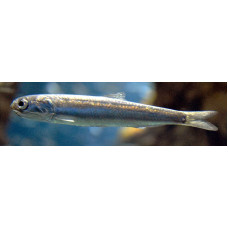Latin name
Engraulis encrasicolus
Other names
Engraulis encrasicolus
Identification
Body elongated, low, covered with cycloid scales, head compressed at the sides, bare. Scales thin, easily shed. Upper jaw protruding forward. Mouth large, semi-deep, lower jaw narrow and long, the posterior end of the long and thin upper jaw extending beyond the edge of the premaxilla. The jaws have small teeth. The ventral keel and lateral line are absent. The bases of the pelvic fins are in front of the vertical of the beginning of the dorsal fin. The mouth opening is very large. Large eyes are close to the end of the snout. There are 12-15 rays on the dorsal fin; 16-20 on the anal fin; 7 on the pelvic fin; gill rays 58-80; vertebrae 39-48; transverse scale rows 41-50. Back green, sides pale silver, abdomen silver-white, gill covers yellowish.
Distribution
Euryhaline species. This species has a very wide range due to its tolerance of wide fluctuations in water temperature (5-28°C) and salinity (7-39 ‰). There are known cases of anchovy entering freshwater estuaries and river mouths. It is found in the eastern Atlantic from the Canary Islands and Morocco to the Bay of Biscay, in all areas of the Mediterranean and Black Seas; in summer it enters the North Sea (up to the coast of southern Norway), the Baltic and the Sea of Azov. It is also found in the Indian Ocean off the coast of Somalia. Within such an extensive range, the species forms several separate forms: Atlantic, Mediterranean, Black Sea and Azov.
Habitat
A gregarious coastal pelagic fish. During the warm season it is mainly found in the surface layers of the water column. In the Mediterranean it winters at depths of up to 150-200m, in the Black Sea up to 140 m (usually 40-70 m). It is found in water temperatures from 5-6 to 28 °C.
Size
Adult length is usually 12-15 cm, not exceeding 20 cm. The recorded weight of Engraulis encrasicolus is 49 g.
Life history and Behavior
The anchovy migrates annually from wintering grounds to spawning and feeding grounds. In summer, they move northwards, rising to the upper layers of water; in winter, they move southwards, sinking to depths of 400 metres. Spawns from April to November, peaking in the warmest months. Life expectancy is 3-4 years; it can reach sexual maturity in its first year of life.
Food and feeding habits
The diet is based on small planktonic crustaceans, especially copepods. Phytoplankton is present in small quantities in the diet. In the absence of zooplankton, the anchovy begins to feed on non-rectobenthic organisms (mysids, polychaetes). Anchovy larvae feed mainly on juvenile copepods.
Reproduction
The optimum water temperature during spawning is 18-26°C. Spawning and fertilisation of the eggs takes place at night, mainly from 20-21 to 24 hours. Spawning is portioned, in 2-3 portions. Eggs are pelagic, transparent, elliptical in shape. The fat droplet is absent. The buoyancy of the eggs is due to the high water content of the yolk (more than 90%). The longitudinal diameter of the eggs is 1.01-1.0 mm, the transverse 0.66-1.5 mm. Incubation lasts about 1.5 days at a temperature of 22-23 °C. At hatching, the larvae are 2-2.5 mm long. The yolk sac is resorbed during the first two days. Metamorphosis ends at a length of 3-3.5 mm. Anchovies grow most rapidly during the first year of life. Mortality during wintering is high in the first two years of life.
| Classification | |
| Phylum | Chordata |
| Class | Actinopterygii |
| Squad | Clupeiformes |
| Family | Engraulidae |
| Genus | Engraulis |
| Species | E. encrasicolus |
| Features | |
| Conservation status | Least Concern |
| Habitat | Pelagic |
| Life span, years | 4 |
| Maximum body weight, kg | 0,049 |
| Maximum length, cm | 20 |
| Sailing speed, m/s | No information |
| Threat to people | Edible |
| Way of eating | Not predator |
European Anchovy
Tags: european anchovy


